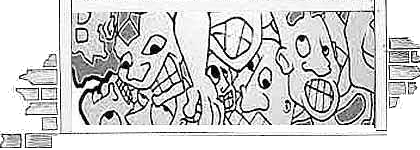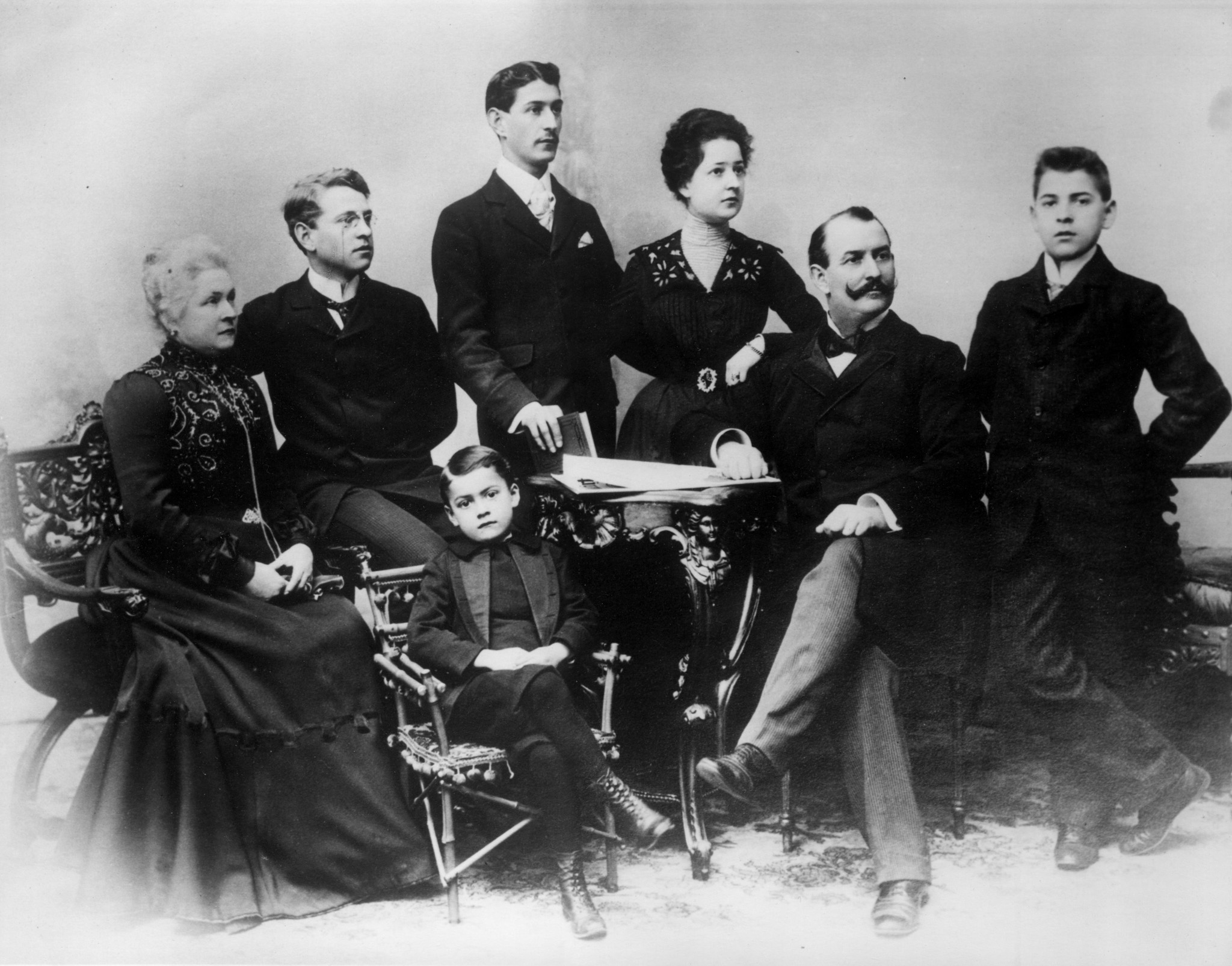
Four subgroups of DNA were created for WAB based on her four grandparents. Time to see what happens when we analyze the yellow coded Perkins subgroup – all the DNA associated with Olive Jean Perkins. As a start, here is the best guess six generation tree for Olive. For those counting, that’s an incredible eight generations from WAB. Let us again think grandparents with their respective color codes. This time it is Olive’s turn. All four grandparents landed in Ontario from various routes.
- We have the Perkins wing, YBB, all of English, Puritan stock who became New England Planters (sometimes called “Preloyalists”) emigrating from New London county, Connecticut prior to the Revolutionary War. The exception are the Creelmans who left Ireland in the 1750’s. Everyone settled in Nova Scotia before moving west to Ontario.
- The Vansickle subgroup, YBP, represents the true Loyalists who moved to Ontario in the years after the War. Isaac and Jane Vansickle came from New Jersey. His family was of Dutch ancestry who arrived in NY around 1650. The Zavitz family, Mennonite settlers in the early 1700’s, lived in Buck County, Pennsylvania. The War split the family with an entire branch leaving for Canada. Jacob and Katherine (Kayser) Minor emigrated in the 1740’s from Saxony, Germany, occupied towns in eastern Pennsylvania, and finally settled Ontario with their three sons. I have admittedly neglected this YBP subgroup over the years. During the write-up, I discovered the zavitzfamily.org website which showed me an error in my tree. The correction, shown in the tree below, made the DNA results much more coherent.
- John Jardine, YPB, a cabinet maker, likely arrived in Wentworth County, Ontario from Scotland in the early 1840’s with his wife and four children. Rachel was either his second or third wife. We know very little about him.
- Rachel McKechnie, YPP, of Irish-Scottish descent, also arrived in the early 1840’s with her brothers. Although she managed to produce one child apiece from her two husbands, she was unlucky in love. Her first husband, whom she wed in 1844, died in 1846. In 1854, she married John, who promptly passed in 1855. No wonder she wears black in all her photos.
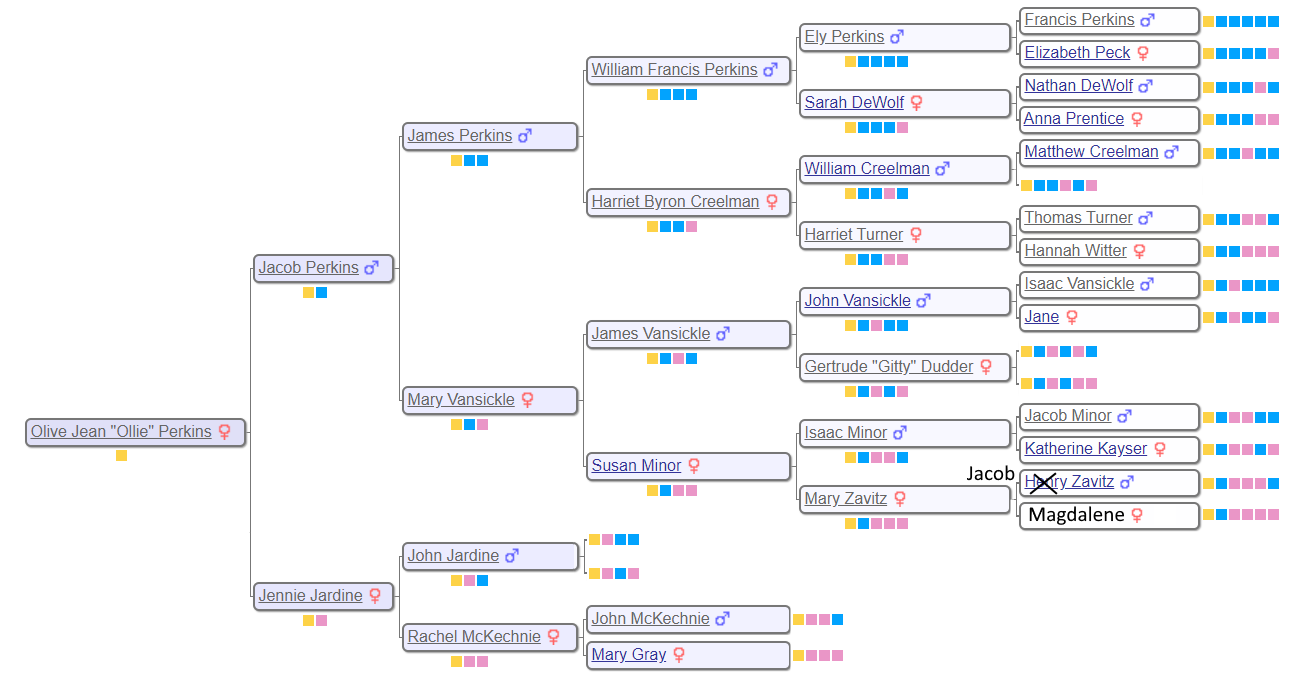
To analyze the data, I reviewed the 30 cM results uncovered in Pt. 1. Then I created a 20 cM genetic affairs chart using the extend-a-cluster technique described in Pt 2. This technique yielded 164 shared matches on ancestryDNA along with 19 clusters and 9 single matches using Genetic Affairs. Ironically, you can ignore all the pure Y’s (descendants of Jacob and Jennie). Y’s are technically associated with every square, so their presence in a given cluster doesn’t really mean anything, and tends to muddle the Genetic Affairs analysis. Also, keep in mind another strange factoid for this Perkins subgroup: there can YB’s but there will only be one pure YP. Jennie was an only child. In order to create another YP, you need a sibling of Jennie or a child of Jennie from another partner. Neither scenario exists, so Jennie Jardine will be the only YP.
I need to make one more disclaimer. This time about endogamy and pedigree collapse as I will use the terms going forward. Both represent “cousin love” as described in Pt. 2. To me, pedigree collapse happens over a few generations and can be hopefully viewed in the family tree as the number of ancestors collapses. Endogamy happens over a longer time as a population stays in a given area. Both have the same effect on clusters. They drive up the amount of shared matching between individuals and they create those gray dots in the cluster diagrams.
With those disclaimers out of the way, let us see what the 30 cM threshold data tells us.
- We can see the division of the male (YBxxx) and female side (YPxxx) of Olive. Notice that the YB box contains a lot of gray squares suggestive of pedigree collapse or endogamy. Cluster 20, a cryptocluster, is likely connected to Olive’s father side due to the one gray dot. Note that this cluster was excluded due to lack of evidence at the time I did the 20 cM run.
- Two grandparents show up at this level, but nothing further back in time: YBP in clusters 18 & 19 and YPB in clusters 14 & 17. YBB and YPP are still missing.
- Genetic affairs does not do a very good job of arranging the cluster in the YB supercluster. Technically, the YB cluster should be located upper left followed by a separate YBP cluster. The presence of all the gray dots is likely confusing the algorithm, as is the presence of the pure Y shared matches.
All in all, very reasonable results. However, we want to push the limits of DNA testing, so it’s time to step down to the 20 cM threshold level.
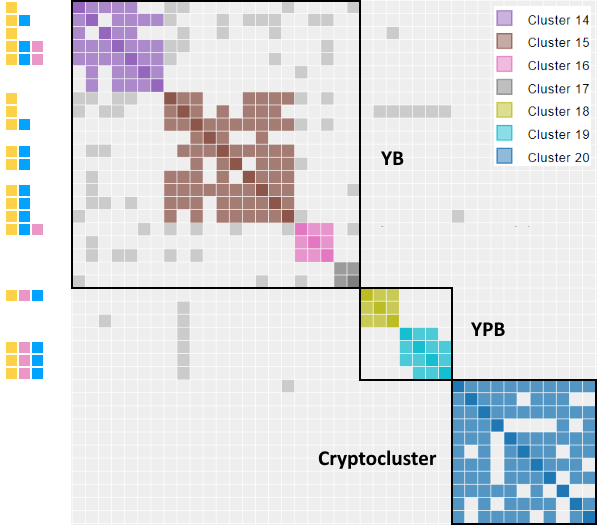
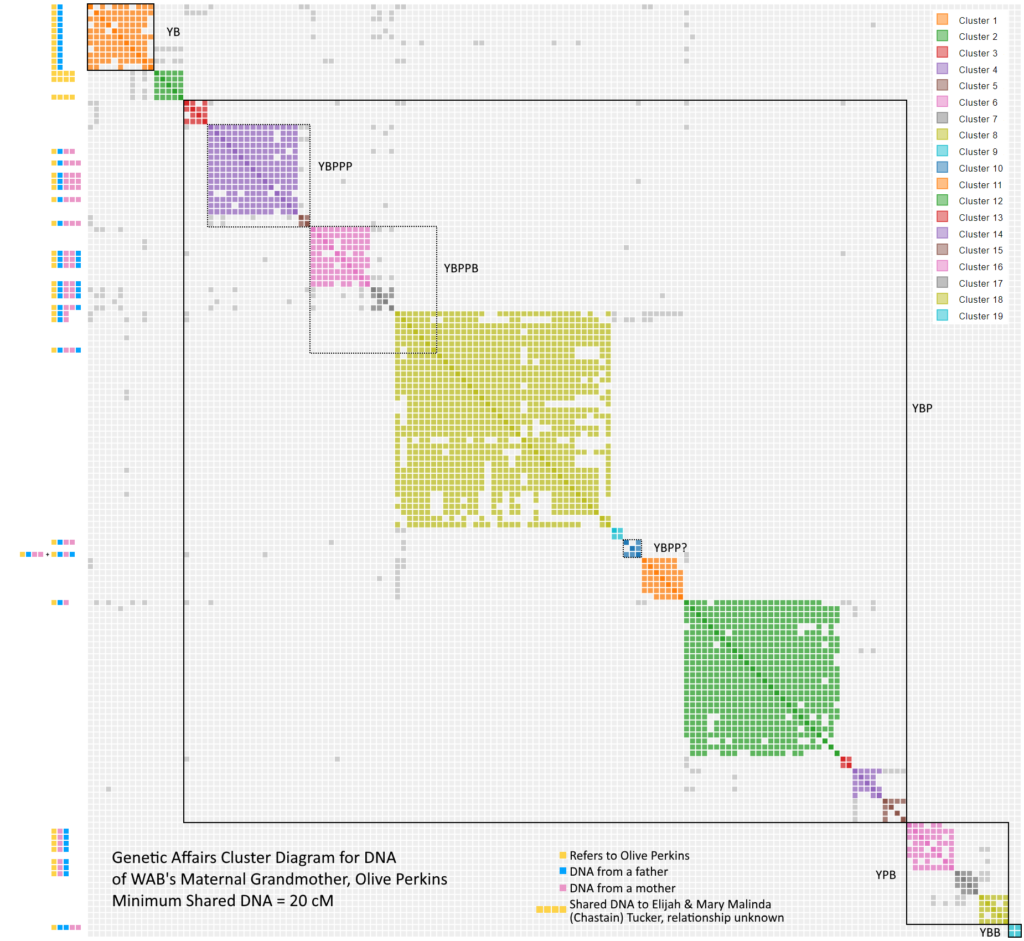
Olive’s Father (YB): Jacob Perkins
Everyone in cluster 1 is YB, having James and Mary (Vansickle) Perkins as common ancestors. If you look at the cluster chart, you can see that YB populates gray from clusters 2 through 14 which means that those clusters are related to Olive’s father’s side.
The picture at the right shows the family around 1870 (note that the photo has an error: Elijah who really “Eli” should be swapped with older brother Jacob). Susan in the middle of the photo had a large family so one should anticipate lots of descendants who tested. Mary Catherine is the little girl in the bottom right. Missing are descendants of Cyrus who settling in England. It’s only a matter of time before someone from this line tests with ancestryDNA.
So every DNA result perfectly matched WAB’s tree – except for one entry – the unexpected NPE . In this case, I uncovered a child born out of wedlock. So while the event happened over 100 years ago and the players have all passed, the offspring still carry a lot of matching DNA. While NPE’s can be difficult to unravel, the solution in this case proved to be quite easy because the birth certificate names the birth parents.
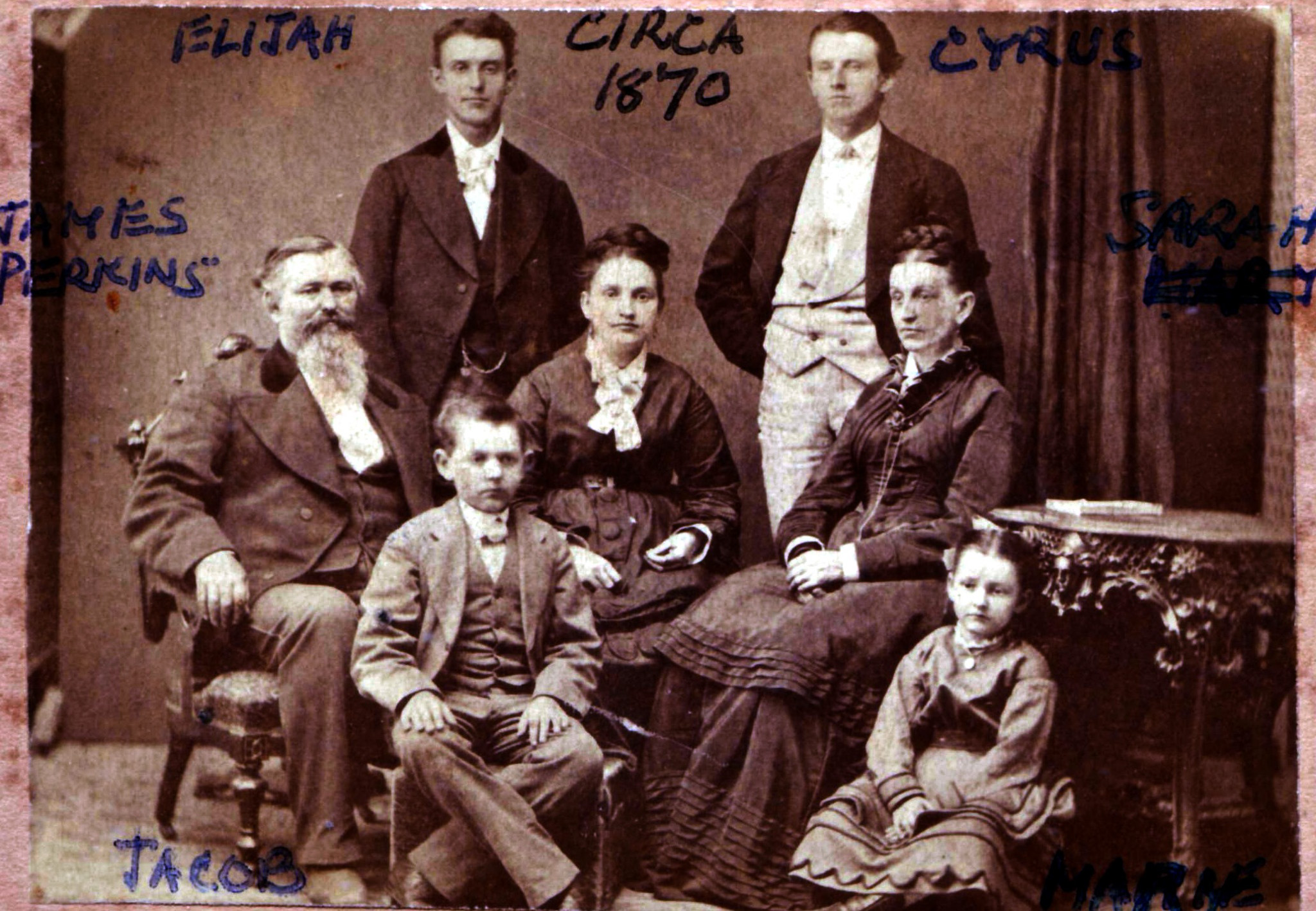
It is instructive to compare my “TrueLine” above to ancestryDNA’s ThruLine for the same couple. Both have advantages. Although the TrueLine is more complete, the ThruLine identified additional shared matches that fall under the 20 cM threshold.
Olive’s Paternal Grandmother (YBP): Mary Vansickle
This supercluster, likely composed of clusters 3 to 15, connects to Olive’s paternal grandmother, Mary Vansickle, and her ancestors. Notice the large number of distant relatives (5th & even 6th cousins) which normally are not able to cross the 20 cM threshold. There were also a large number of unidentified shared matches. I would argue that this number of shared match above 20 cM is impossibly large and that other forces must be at work.
Let us start with a new wrinkle in the DNA sharing game. Mary Vansickle had a special relative, Ann Minor, who turns out to be a “double cousin” (they are cousins through both grandparents). This relationship differs from pedigree collapse because the pedigree does not get collapsed for either party. However, descendants will show an increased amount of shared DNA. TC in cluster 10 descends from Ann Minor. TC completely destroys my coloring code scheme since he is both YBPP and YBPB. However, TC shares a comparatively small 21 cM over one segment . I do not believe that this relationship has much impact on the size of the supercluster.
Most of the identified shared match of distant relatives are YBPPB (common ancestors of Jacob and Katherine Minor) and YBPPP (common ancestors of Jacob & Magdeline Zavitz). Most are found in clusters 4, 5, 6, and 7 but also scattered elsewhere. These shared matches also have the distinctive gray dots. When the Loyalists settled in Ontario, several generations of intermarriage occurred, particularly in the Zavitz and Minor families. The message from the lead historian of the Zavitz family site talks about his own lineage: “I am descended from 2 of Mary Zavitz’s brothers (Henry [Dad], Jacob [Mom]) and am related through a lot of other lines as well.” We have a classic case of pedigree collapse at work here, which magnifies the shared matches beyond the predicted amount and creates the gray dots.
However, many of the clusters appear to be pseudoclusters with parasite shared matches attached to a legitimate match, which is indicative of pile up (see Pt 2 for a better description). Clusters 8 and 12 stand out due to their large size, but others, such as clusters 3, 14, 15, could also be included. These parasitic shared matches make it difficult for Genetic Affairs to arrange the clusters accurately. Remember that YPB should be in the upper left, followed by distinctive YPBP, YPBB clusters etc.
The fact that we see both endogamy (lots of gray dots) and pile up (shared matches with no connection to the tree) in the same YPB supercluster and all above the 20 cM threshold would seem to be more than coincidence. So maybe my understanding of the DNA needs more refinement. Nevertheless, YPB dominates the Genetic Affairs cluster diagram, which is confirmed by the large number of matches seen the various YPB ThruLines shown below. A lot of shared matches exist for this line, even if I do not think they are all real.
Speaking of ThruLines, the output generated for Jacob and Magdalene Zavitz shows why I have a healthy distrust of ThruLines. According to this chart, our ancestor Mary Zavitz is both sister and daughter to Henry Zavitz (there is an obvious reference here to the movie, “Chinatown”). This error occurs because ancestryDNA employs user submitted trees that claim erroneously that Mary is Henry’s daughter. We made this error because somebody in the past made this error, and we all copied it. So I correct the mistake, but ancestryDNA cannot handle the truth.
Olive’s Maternal Grandfather (YPB): John Jardine
Clusters 16, 17 and 18 all relate to Olive’s maternal grandfather, John Jardine. As mentioned, John Jardine was married prior to his arrival to Ontario. The TrueLine below shows descendants of these two marriages who have had their DNA tested.
Now, one of trees of a shared matches in cluster 16 did not lead to John Jardine, but rather to a Margaret Jardine. Like John, she moved to Canada from Scotland after her marriage to Hugh Campbell. I rearranged WAB’s ancestryDNA tree assuming Margaret is John’s sister to test this hypothesis. The resulting ThruLine supports this assumption. Turns out that Margaret and John can be found in the same marriage register when they both wed in Greenock, Scotland, a little northwest from Glasgow. Based on this DNA result and this extra traditional evidence, I feel confident adding Margaret (Jardine) Campbell to the family tree. So while we still do not know the parents of John and Margaret, we have expanded the family and have learned the location of their home in Scotland.
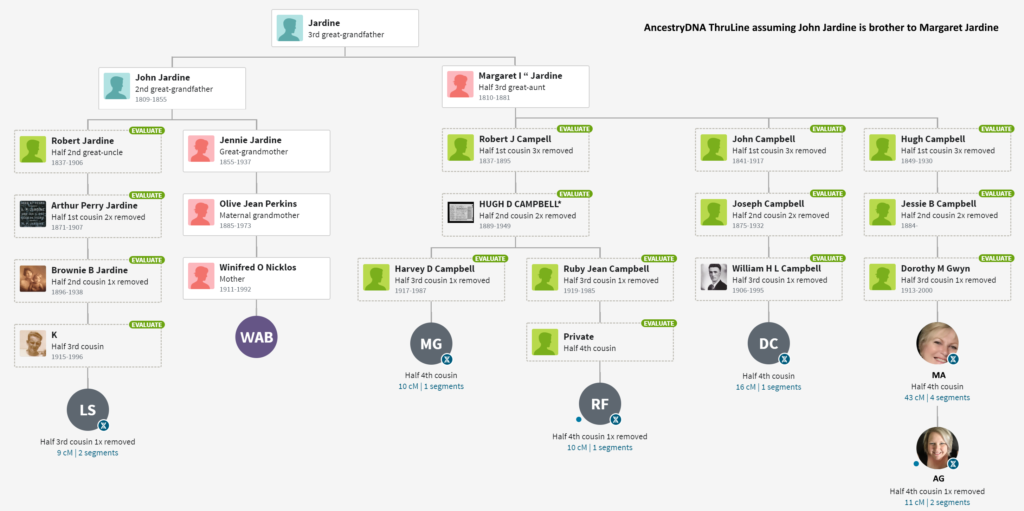
Olive’s Paternal Grandfather (YBB): James Perkins
A single cluster, 19, refers back to Olive’s paternal grandfather (YBB), James Perkins. This match to user junedanaher42 is YBBPP, corresponding to Harriet Turner, making the common ancestors Thomas and Hannah (Witter) Turner. This does not seem to make much sense. Where are the YBB’s, YBBB’s or the YBBP’s who are more closely related? To examine that question, look at ThruLines for each these missing matches.
Neither ThruLines nor Genetics Affairs identified a YBB, a descendant of William & Harriet (Creelman) Perkins. I looked everywhere even combing through ancestryDNA trees. Likely no one has tested yet, but I will remain about concerned about a NPE until I find someone. Fortunately, both YBBB and YBBP show shared matches with ThruLines with some matches exceeds my magical 20 cM threshold. Genetic affairs missed the 25 cM user janiceann11 who shares DNA with junedanaher42. ThruLines also identified a 20 cm user EM, who has no shared matches.
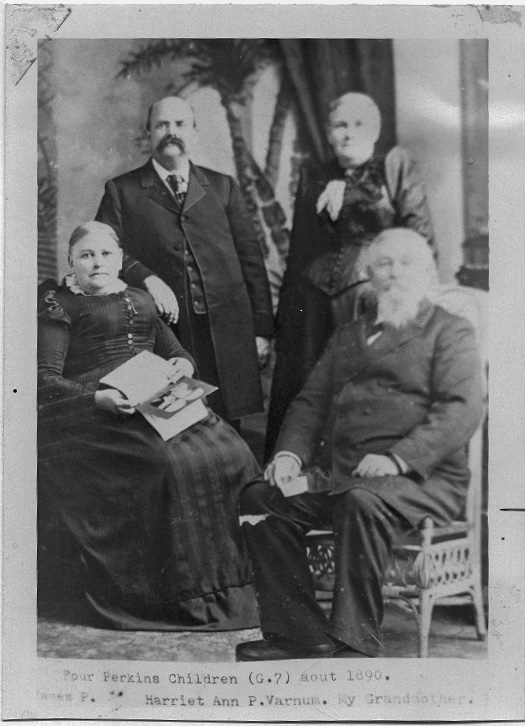
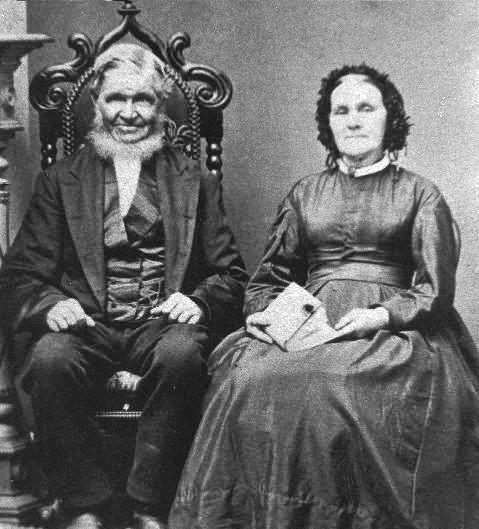
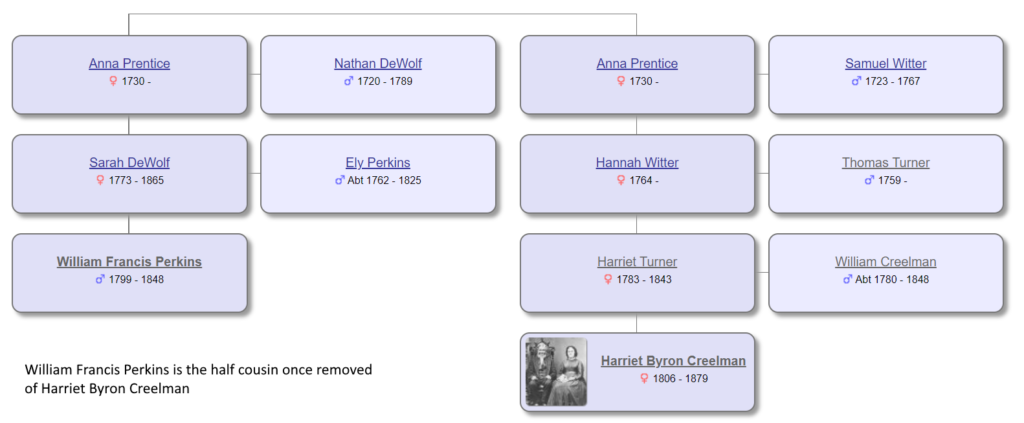
The Preloyalists moved an entire community to Nova Scotia. This large number of about 5000 settlers allowed the Perkins line to avoid intermarriage, keeping the level of shared matches low. However, intermarriage did occur. William Francis Perkins and Harriet Creelman are, in fact, related. In addition, there are several documented cases of marriage between the Perkins and Ely families during their time in New London county. The effect of these unions may have given junedanher42, janiceann11 and EM a little DNA shared match boost to carry them past the 20 cM threshold. Otherwise, any pedigree collapse here has little effect on this branch compared to the Vansickles.
Olive’s Maternal Grandmother (YPP): Rachel McKechnie
Only one single match was identified that can be traced to Olive’s grandmother, Rachel McKechnie (YPP). The match comes from the aptly named S McKechnie who shares 28 cM.
Below is a ThruLines representation for Rachel and her siblings. This chart looks quite accurate since Robert, Stephen, John and Jessie are all documented siblings of Rachel. Note that BR had a match of 28 cM but she does not share DNA with anyone else. None of the other matches has a guess about parents of either John McKechnie or Mary Gray. No shared matches suggest an avenue to explore. So, unfortunately, we continue to hit our heads against the proverbial brick wall.
The photo to the right shows Rachel with 3 of her brothers: John, Thomas and Stephen. I think that this photo also has a error. According to my research, Thomas (born 1822) died Illinois in 1872 at the age of 49. The guy in the upper right is more likely Robert born in 1807. He looks like the oldest, and the four people in the photo all lived in Canada.
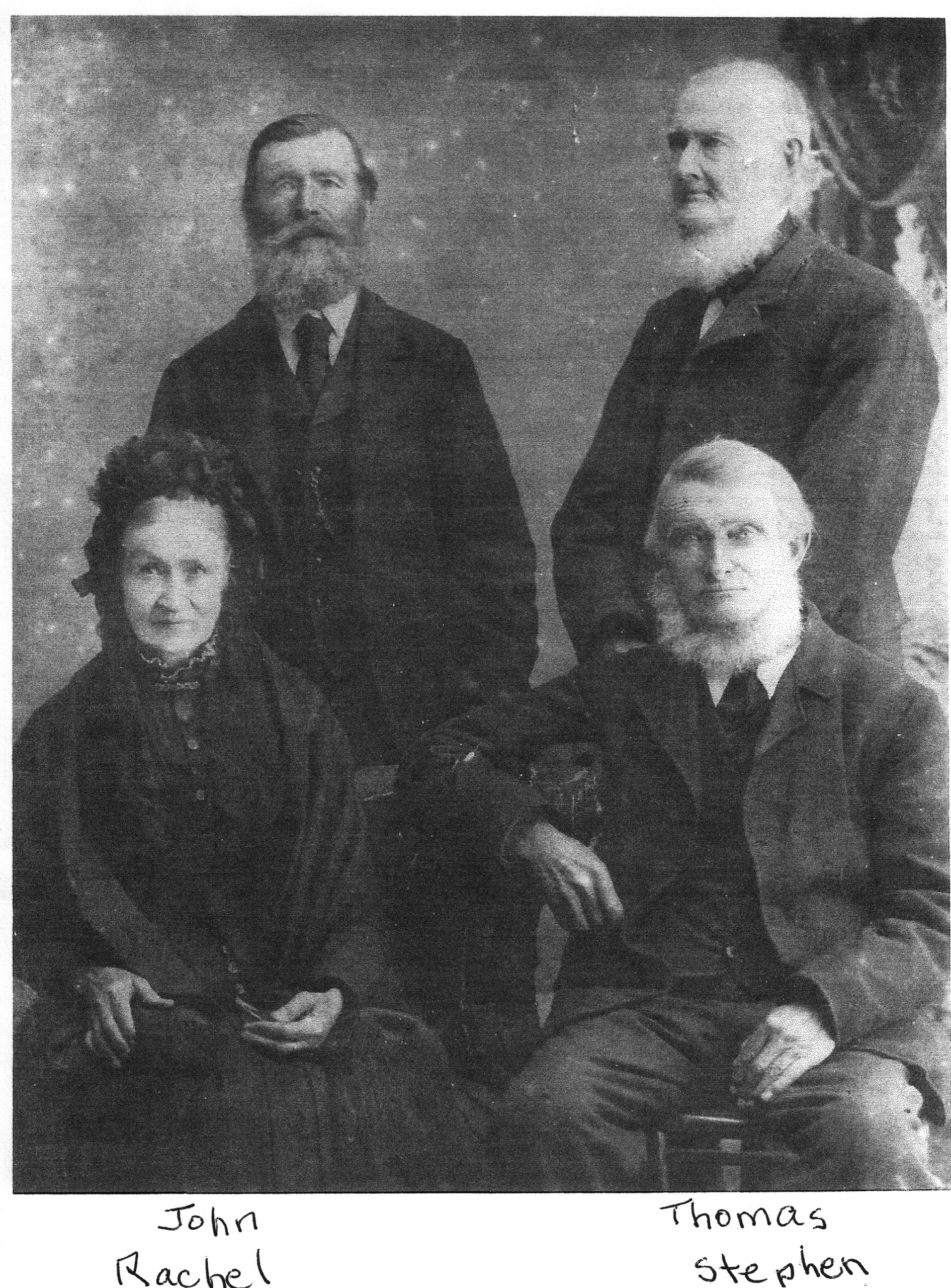

Cluster 2
We finish off with a great little whodat cryptocluster. The common ancestors in cluster 2 would seem to be Benjamin Elijah “Lidge” Tucker b. 1849 in Arkansas died 1918 and Mary Malinda Chastien b. 1847 in Kentucky. They married in 1872 in Arkansas. How does the Perkins DNA get from Canada to Arkansas in mid 1870? Good question. The cluster shares gray with cluster YB but shares no gray with the rest of the chart which is almost all YBPx. Therefore cluster 2 most likely points to a YBB. These observations will only go so far. YBB could point to James Perkins, but equally to his brother William or sisters Harriet or Sarah. Children of these siblings are also YBB. So you still need to connect dots between Arkansas and Ontario through classical genealogical research.
Conclusion
I admit it. For years, I have focused attention on the Perkins surname at the expense of the others in this yellow subgroup. Cluster analysis forces one to consider all sources of DNA equally. In this case, we see the Vansickle line dominate. Cluster analysis has also opened up new areas for exploration. There is cryptocluster 20 in the 30 cM chart and cryptocluster 2 at 20 cM, among others. Now that we know where the brick walls are located, it would also be nice to drill down a little further, say 12-15 cM threshold, to look for additional clues in the Jardine and McKechnie branches. At that level, maybe I might even uncover additional matches in my favorite stomping ground of the Perkins line.
